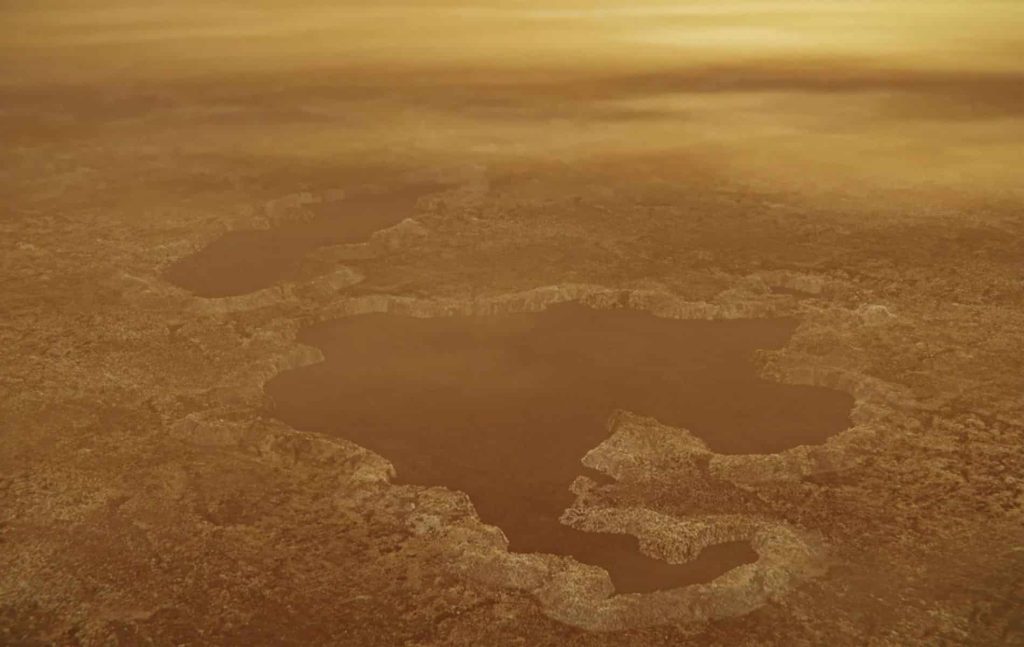It is likely to be powerful enough to erode banks and coastlines.
Titan is undoubtedly one of Saturn’s most magnificent moons. This is mainly due to the fact that the Moon, like the Earth, has stable fluids on its surface. In fact, Titan is the only other celestial body in our solar system that currently has active rivers, lakes, and seas. After taking a closer look at these waters, researchers have now discovered something very special.
Liquids
The hydrological cycle on Titan works in a similar way to that on Earth, with one key difference: Instead of water, Titan’s lakes and seas contain methane and ethane. On Earth, these hydrocarbons exist mainly in gas form. But Titan is so cold that these materials behave like liquids on the moon. The rivers are therefore thought to be full of liquid methane and ethane, which flow into large lakes and seas, some of which are similar in size to those on Earth. In 2007, the presence of this water on Titan was confirmed through images taken by NASA’s Cassini spacecraft. Since then, scientists have intensively studied these images and others to understand more about the mysterious liquid world.
waves
Geologists from the Massachusetts Institute of Technology recently closely examined Titan’s beaches and coastlines. Using simulations, they have now shown that the Moon’s great lakes and seas are likely to have waves. This is special. This means that the avid surfer on Titan can indulge himself.
Controversial topic
By the way, this is not the first time that researchers have mentioned the possibility of finding waves in Titan’s surface waters. Scientists have previously seen indirect and sometimes confusing signals of wave activity on images. The presence of waves on Titan has been a somewhat controversial topic since Cassini discovered fluids on its surface. “Some observers looking for evidence of waves saw nothing and concluded that the water was mirror smooth,” said study leader Rose Palermo. “Others noticed some roughness on the surface of the liquid, but were not sure if it was due to the waves.”
Another approach
To uncover the truth once and for all, researchers took a different approach this time. “Instead of looking directly for wave-like features in images of Titan, we took a different approach,” explains researcher Taylor Perron. “By just looking at the shape of the banks and shorelines, we wanted to determine what was causing the erosion.”
Stripping
They began by modeling the erosion processes that occur on Earth. They then applied their models to Titan’s water to see which erosion process best explains the edges of the water in Cassini’s images. The researchers looked at three possible scenarios for what might happen: no coastal erosion, wave-induced erosion, and “regular erosion,” where liquid passively dissolves coastal material or the coast gradually collapses under its own weight. “We discovered that regular wear produces a very different finish than wave wear,” Perrone says. “Flooded river valleys make it look like a flying spaghetti monster, but the two types of erosion lead to very different end results.”

Waterfronts
After further analysis, the researchers reached a clear conclusion: the waterfronts were likely eroded by waves. “From our results we can conclude that if the banks and coasts of Titan’s lakes and seas have indeed been eroded, then waves are likely the main factor,” Perron said. “If we were standing at the edge of the sea on Titan, we might see waves of liquid methane and ethane crashing onto the shore. These waves would be able to erode the materials that make up the coast.
Important
Why is it important to know whether Titan has waves? This could give scientists an idea about the moon’s climate, such as the strength of the winds that can create waves. This information could also help predict how the shape of Titan’s seas will evolve over time. Researchers are now trying to figure out how strong the winds on Titan are to generate waves that could constantly erode water edges. They’re also trying to figure out which directions the wind is blowing, primarily based on the shape of Titan’s banks and coasts.
Researchers confirm this Their findings Not final. To determine whether there are indeed waves on Titan, direct observations of wave activity on the moon’s surface are necessary. But if the team is right, it could have important implications. “Titan offers a unique example of a completely original system,” Palermo points out. “Studying them could give us key insights into how waterfronts erode without human influence. This knowledge may help better manage our banks and coastlines on Earth in the future.”

“Coffee buff. Twitter fanatic. Tv practitioner. Social media advocate. Pop culture ninja.”











More Stories
Which can cause an increase in nitrogen.
The Central State Real Estate Agency has no additional space to accommodate Ukrainians.
The oystercatcher, the “unlucky national bird,” is increasingly breeding on rooftops.